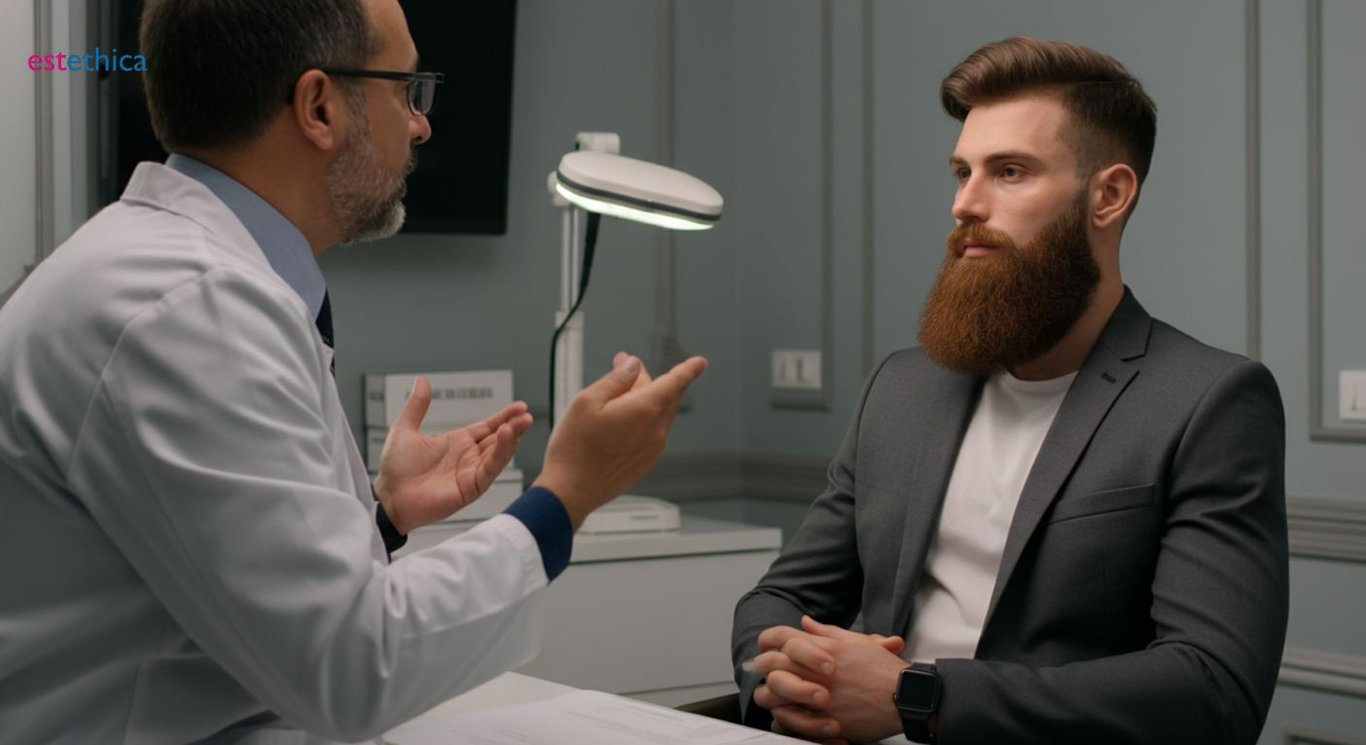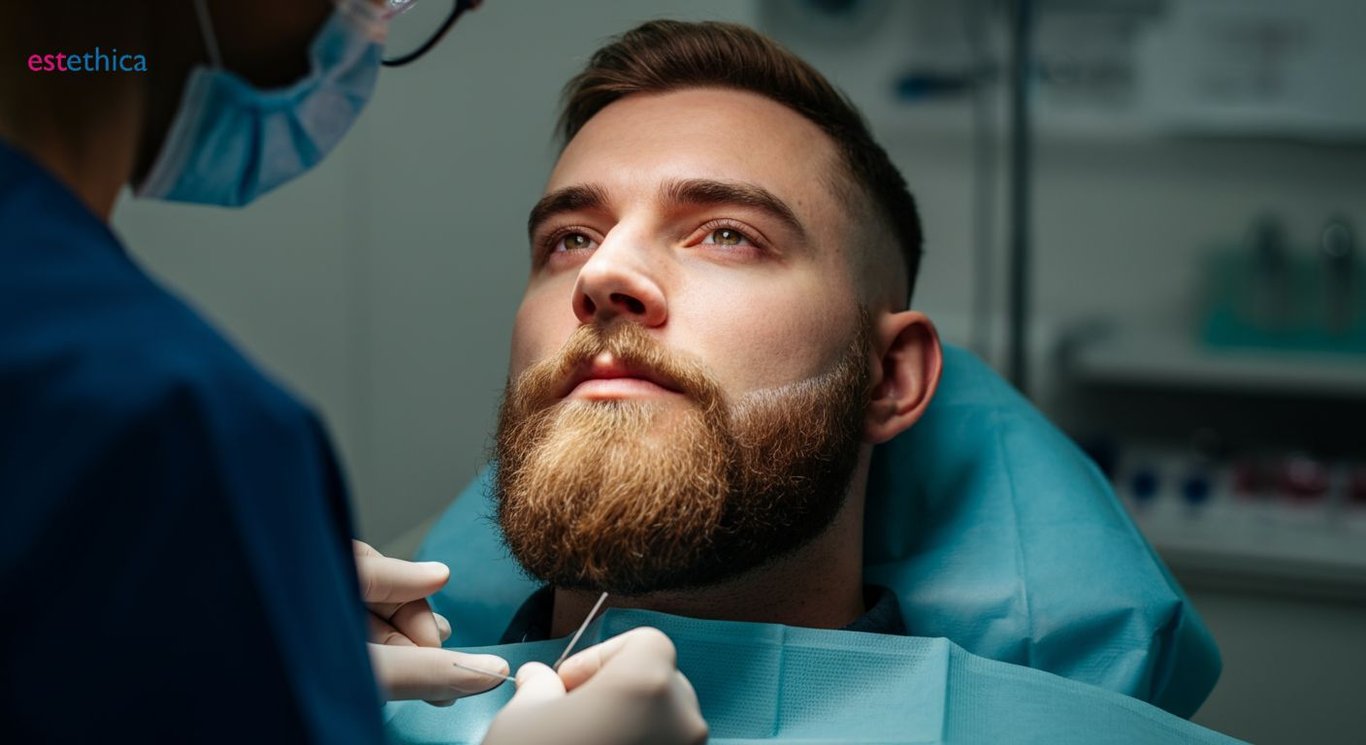Unlock Confidence with Beard Transplantation
Discover how beard transplantation can redefine your look and boost your confidence with natural, full beard growth.
Boost your confidence and redefine your image with a beard transplantation. This groundbreaking procedure offers remarkable results for those struggling with patchy or thin facial hair. Discover how beard transplantation can transform your facial aesthetics, offering a permanent solution to hair density issues.
Understanding the Beard Transplant Process
The Beard Transplant Procedure Explained
The beard transplant process involves transferring hair follicles from a donor site, usually the back of the scalp, to the facial area. This meticulous procedure ensures natural growth patterns for a seamless look. The technique used is similar to hair and beard transplant methods, ensuring that the transplanted hair blends naturally with existing facial hair. For instance, a patient with patchy beard growth can achieve a fuller look through this procedure.
Factors Influencing Beard Transplant Cost
While discussing the beard transplant process, it's important to consider various factors that can influence the cost. These factors include the complexity of the procedure, the expertise of the surgeon, and the clinic's location. For example, a renowned beard transplant clinic in a metropolitan area might charge differently compared to a smaller clinic. Understanding these factors can help individuals make informed decisions about their facial hair restoration journey.
Key Benefits of Beard Transplants
- Natural-looking results that mimic natural beard growth patterns.
- Permanent solution for those struggling with patchy or thin beards.
- Boosts confidence and enhances facial aesthetics.
These benefits make beard implants a popular choice among individuals seeking to enhance their facial hair. The procedure not only improves appearance but also provides a long-term solution for beard growth issues.
Steps in the Beard Transplant Process
- Consultation with a specialist to assess beard transplant suitability.
- Harvesting hair follicles from the donor site, typically the scalp.
- Implanting the follicles into the facial area for natural growth.
Each step is crucial to ensure the success of the beard hair surgery. The procedure requires precision and expertise to achieve the desired outcome. For more insights into beard transplants, you can explore expert insights.

Choosing the Best Beard Transplant Surgeon
Evaluating Surgeon Expertise and Experience
When selecting a beard transplant surgeon, prioritize those with extensive experience in facial hair restoration. A surgeon's expertise is crucial for achieving natural-looking results. For instance, a surgeon who has performed numerous beard implants will have refined techniques that ensure seamless integration with existing facial hair. Additionally, board certification is a key indicator of a surgeon's qualifications and commitment to maintaining high standards in beard hair surgery.
Understanding Beard Transplant Pricing Factors
While cost should not be the sole factor in choosing a surgeon, understanding the elements that influence pricing can guide your decision. Factors such as the surgeon's reputation, the complexity of the procedure, and the clinic's location can all impact the overall cost. For example, a renowned clinic specializing in the latest beard transplant techniques might have different pricing compared to a general practice. It's essential to weigh these factors alongside the surgeon's expertise to ensure the best outcome for your facial hair implants.
Key Qualities of a Top Beard Transplant Surgeon
- Proven track record of successful beard transplants with natural results.
- Comprehensive understanding of facial hair growth patterns and aesthetics.
- Commitment to using advanced techniques and maintaining patient safety.
These qualities are vital in ensuring that your beard transplant not only meets but exceeds your expectations. A skilled surgeon will tailor the procedure to your unique facial structure, enhancing your overall appearance.
Steps to Finding the Right Surgeon
- Research potential surgeons and review their credentials and patient testimonials.
- Schedule consultations to discuss your goals and evaluate the surgeon's approach.
- Assess the clinic's facilities and the support team involved in the procedure.
Following these steps can help you identify a surgeon who aligns with your expectations and ensures a successful beard transplant experience. By prioritizing expertise and patient care, you can achieve the desired results and enjoy the benefits of enhanced facial hair.

Exploring Facial Hair Restoration Techniques
Innovative Beard Transplant Techniques
Facial hair restoration has evolved significantly, with techniques like Follicular Unit Extraction (FUE) and Follicular Unit Transplantation (FUT) leading the way. These methods offer distinct advantages, such as minimal scarring and natural hair growth patterns. For instance, FUE involves extracting individual hair follicles, which is ideal for those seeking a seamless look. In contrast, FUT might be preferred for those requiring a higher density of hair. Both techniques ensure that the transplanted hair integrates naturally with existing facial hair, enhancing the overall appearance.
Understanding Beard Transplant Pricing Factors
While the cost of a beard transplant can vary, understanding the factors that influence pricing is crucial. These factors include the complexity of the procedure, the expertise of the surgeon, and the clinic's location. For example, a renowned clinic specializing in the latest beard transplant techniques might have different pricing compared to a general practice. It's essential to weigh these factors alongside the surgeon's expertise to ensure the best outcome for your facial hair implants.
Advantages of Modern Beard Transplant Techniques
- Minimal recovery time, allowing patients to resume daily activities quickly.
- Advanced techniques ensure a natural appearance with minimal discomfort.
- Customizable options to suit individual facial hair goals and preferences.
These advantages make modern beard implants a preferred choice for those seeking to enhance their facial hair. The procedures not only improve appearance but also provide a long-term solution for beard growth issues.
Steps in the Beard Transplant Process
- Consultation with a specialist to assess beard transplant suitability.
- Harvesting hair follicles from the donor site, typically the scalp.
- Implanting the follicles into the facial area for natural growth.
Each step is crucial to ensure the success of the beard hair surgery. The procedure requires precision and expertise to achieve the desired outcome. For more insights into beard transplants, you can explore expert insights.

Caring for Your New Beard Post-Transplant
Essential Post-Transplant Care Tips
After undergoing a beard transplant, proper care is crucial to ensure optimal healing and growth. Adhering to your surgeon's guidelines is essential. For instance, moisturizing the transplanted area can prevent dryness and irritation, promoting healthy hair growth. Avoiding direct sun exposure is also vital, as UV rays can damage sensitive skin and newly implanted follicles. Gentle grooming techniques, such as using a soft brush, help maintain the integrity of the transplanted hair without causing trauma.
Understanding the Importance of Post-Transplant Care
Post-transplant care is not just about healing; it's about maximizing the potential of your new beard. By following recommended practices, you can enhance the results of your facial hair restoration. For example, using a mild shampoo designed for sensitive skin can prevent irritation and support the health of the transplanted area. Additionally, maintaining a balanced diet rich in vitamins and minerals can aid in the recovery process and promote robust hair growth.
Key Steps for Effective Beard Care
- Moisturize the transplanted area regularly to prevent dryness.
- Avoid direct sun exposure to protect sensitive skin and follicles.
- Use gentle grooming techniques to maintain hair integrity.
These steps are essential for ensuring the success of your beard hair surgery. By prioritizing care, you can enjoy a fuller, healthier beard that complements your facial features.
Benefits of Proper Post-Transplant Care
- Promotes faster healing and reduces the risk of complications.
- Enhances the appearance and longevity of the transplanted beard.
- Supports overall skin health and hair growth.
By investing time and effort into post-transplant care, you can ensure that your beard implants achieve the desired results, providing a long-term solution for facial hair enhancement.
Innovative Beard Transplant Techniques for Natural Results
Excellence in Beard Transplant Process with Optimal Care
Frequently Asked Questions
How does a beard transplant work?
Is a beard transplant permanent?
What are the latest beard transplant techniques?
What should I expect during the recovery period after a beard transplant?
How do I choose the best beard transplant surgeon?
Discover the Path to 'Healthy Beauty' with estethica! Call Now for Your Free Consultation.
📞 Speak with Our Experts Today!